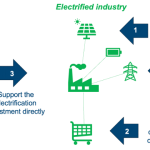

Securing the Digital Frontier: The Importance of Connection Verification for Business Websites
In today’s online business landscape, ensuring a safe and secure connection isn’t just a technical necessity but a critical element to building trust with visitors. Many websites, ranging from small local businesses to large industrial manufacturing companies, rely on advanced security systems like Cloudflare to protect their digital assets. This article will explore the process of verifying that a visitor is human, the role that security services play, and what this means for industries such as automotive, electric vehicles, and even sectors influenced by business tax laws and economic news.
Unpacking the Website Connection Verification Process
When you visit a secure website, you might be prompted with a simple message that asks you to wait a few seconds while your browser proves that you’re not a bot. The process, often powered by security platforms like Cloudflare, involves a sequence of checks designed to protect visitors and businesses alike. This straightforward-sounding process is actually packed with a number of steps, each designed to filter out automated traffic and ensure that only genuine users gain access.
These steps include analyzing IP addresses, examining browsing behaviors, and assessing other digital signals. While the verification message might seem off-putting to some visitors, it is a key component in warding off cyberattacks and keeping data secure.
How Verification Systems Bolster Business Security
The security layer provided by connection verification tools acts like a digital bouncer, ensuring that the only individuals who enter the online space are legitimate users. Let’s take a closer look at how this benefits businesses:
- Reduces Suspicious Activity: Automated bots are often used to launch attacks or scrape sensitive data. Verification measures help filter these out before they can cause harm.
- Improves User Trust: Even if the process seems a bit nerve-racking, customers quickly learn to appreciate a secure site. Many are more likely to trust a site that takes steps to ensure safety.
- Enhances Overall Site Performance: While it might add a few extra seconds to load times, the overall benefit of a safe browsing experience can boost customer confidence and ultimately lead to more conversions.
- Maintains Brand Reliability: For brands that operate in sensitive areas like business tax laws or economic news, maintaining a robust digital presence is essential. Security verifications contribute by preventing unauthorized access and misinformation.
Understanding the Role of Cloudflare in Business Security
Cloudflare is one of the key players in the digital security sphere, safeguarding websites from potential threats with state-of-the-art technology. Its involvement can be seen by many businesses that experience a brief wait period while their connection is verified. Here’s what Cloudflare brings to the table:
- Advanced Threat Detection: Cloudflare uses sophisticated algorithms to analyze every visitor’s digital footprint. This includes checking for any signs of unusual activity that might indicate a bot or malicious software.
- Global Network Integration: With a vast network of servers across the globe, Cloudflare ensures that businesses, regardless of their location, receive consistent protection.
- Customizable Security Settings: Companies can tailor the level and nature of their security checks. This flexibility allows businesses from varied industries to adjust the system based on their specific requirements and acceptable risk levels.
- Performance Optimization: Despite adding an extra layer of security, Cloudflare also works on reducing load times and optimizing content delivery, ensuring that a secure site does not come at the expense of user experience.
Ensuring a Smooth User Experience While Security Measures Operate
In the race between speed and safety, online businesses must strike the right balance. While advanced security measures are off-putting to some customers due to even a slight delay in loading times, these steps are indispensable. The trade-offs include:
- Short Wait Times: Verification steps can add a few extra seconds to the connection process. However, for many users, this is a small price to pay for enhanced security.
- User Education: Businesses can benefit from educating users about the necessity of these checks. A short explanation on the landing page can allay fears of being stuck in an endless loop.
- State-of-the-Art Tech Integration: By integrating modern optimization strategies and caching techniques, companies can reduce the perceived wait time.
In practice, a delay during connection verification is a sign of an active defense mechanism. The extra seconds are used to work through the tricky parts of ensuring each visitor is legitimately a human. Compared to the potential long-term damage from a security breach, this small delay is both essential and acceptable.
Small Business Websites: A Closer Look at the Fragile Intersection Between Speed and Security
For many small business owners, the digital space is an intimidating arena. The process of setting up a website that focuses on both performance and security is not always straightforward, often filled with tangled issues and complicated pieces that require a lot of attention. Small businesses must consider the following improvements when planning their online strategies:
| Aspect | Challenges | Solutions |
|---|---|---|
| Website Speed | Potential delays due to verification processes | Optimize assets and choose a Content Delivery Network (CDN) |
| User Trust | Users might feel frustrated by wait times | Add informative tooltips and reassurance messages |
| Security | Risk of automated bot attacks | Implement layered security measures including Cloudflare |
Small business sites, in particular, face the challenge of balancing a fast user experience with the need to protect their sites from cyberattacks. The detailed work required to manage website security can appear off-putting. Yet, if these tricky parts are handled correctly, the benefits far outweigh the delays.
Industrial Manufacturing and the Digital Age: Security as a Competitive Edge
For industrial manufacturing companies, digital security might be just one aspect of a larger digital transformation. These firms often manage sensitive data and control critical infrastructure through their online portals. Verifying human access before entry isn’t just about preventing unwanted robots—it’s about ensuring that each connection is a step in a secure digital dance.
Industrial companies often have to work through multiple small details when integrating such security measures into their systems. Some industry-specific security benefits include:
- Protecting Intellectual Property: Manufacturing companies invest heavily in research and development. Security verifications help keep patents, product designs, and prototypes safe from intellectual theft.
- Maintaining Operational Integrity: In an era where cyber threats are constantly evolving, industrial systems must be protected from potential disruptions that could affect production lines.
- Regulatory Compliance: Many manufacturing companies face strict regulatory requirements, and robust security measures help meet those criteria.
- Enhanced Customer Confidence: Clients are more likely to do business with a manufacturer that can guarantee the safety and confidentiality of their transactions and data.
Industrial manufacturers must figure a path through a maze of digital security challenges, where the balance between advanced technology and user accessibility is continually being refined.
The Automotive and Electric Vehicle Sectors: Driving Forward with Secure Online Platforms
The automotive industry, along with the emerging electric vehicle market, has seen rapidly increasing digital integration. As companies in these fields increasingly rely on online platforms for everything from customer service to vehicle diagnostics and remote updates, establishing robust security protocols becomes super important.
Key benefits for these industries include:
- Firmware Updates and Data Protection: Vehicles now communicate with central servers for updates and diagnostics. Ensuring that only authorized users can access these connections is crucial.
- Customer Data Security: With the increasing amount of personal data stored in vehicle systems and connected apps, verifying human access helps shield sensitive information.
- Preventing Unauthorized Access: Robust network security helps prevent hackers from taking control of vehicle systems—a risk that grows as cars become more connected.
- Brand Reputation: A security lapse in the automotive sector can lead to recalls, lawsuits, and a diminished sense of safety. By managing digital risk, automotive companies can protect not just vehicles but consumer trust.
Securing online platforms isn’t a one-size-fits-all approach in the automotive industry. It requires close attention to the small distinctions between various security needs, ensuring that every step from verification to data encryption is handled with precision.
Cybersecurity’s Impact on Digital Marketing and Customer Acquisition
In the realm of business marketing, online security isn’t just a precaution—it’s a foundation for building trust with customers. Recently, many marketers have taken a closer look at how security verifications affect the overall user experience and brand perception.
Some of the considerations include:
- Building Trust With Visitors: When customers see that a business is taking extra precautions to secure their data, they tend to feel more comfortable engaging and making purchases.
- Transparent Communication: Educating users about why a few seconds of verification are necessary can transform a nerve-racking pause into a reassuring moment of transparency.
- Enhanced Customer Retention: A secure platform reduces the risk of data breaches, which can be costly not just financially but in terms of lost customer loyalty.
- SEO and User Experience: With search engines increasingly favoring secure websites, robust online security indirectly contributes to better rankings and more organic traffic.
Marketers must work through the delicate trade-off between security and speed. This requires figuring a path that reassures customers while also maintaining an efficient, fast-loading website. In many ways, the use of sophisticated verification systems is a cornerstone in modern digital marketing strategies.
Tax Laws, Economic News, and Their Influence on Secure Digital Systems
The financial landscape is constantly in flux, driven by changes in business tax laws and the overall economic climate. Amid these shifts, companies are required to remain vigilant against cyber threats that can compromise both financial data and strategic positions.
There are several reasons why online security remains central to these discussions:
- Regulatory Compliance: Businesses need to ensure that their websites have the appropriate security measures in place to abide by evolving tax and business regulations.
- Protection Against Fraud: With cyberattacks on the rise, a secure site that verifies human users can help protect against fraudulent transactions which, in turn, keeps the economic news environment stable.
- Economic Stability: The trust that businesses build online is linked to broader economic confidence. Secure systems contribute to a more stable financial environment by preventing data breaches and other security lapses.
Businesses must work through these small distinctions in financial regulations while integrating digital security. The process, though sometimes overwhelming, is a necessary step toward achieving long-term stability and compliance in a digital-first economy.
Strategies for Enhancing Online User Experience While Maintaining Robust Security
Having a secure website is a must-have for any business, but nothing is more critical than ensuring that the end-user is not left frustrated by excessive wait times or confusing security pop-ups. Companies are increasingly adopting initiatives to smooth out the user experience without compromising on security. Some effective methods include:
- Streamlined Verification Processes: Optimize scripts and use fast-response networks to minimize delays caused by security checks.
- User Interface Improvements: Use clear and friendly messaging during verification so that users understand the process rather than feeling overwhelmed by it.
- Mobile Optimization: Since many users access websites on their smartphones, ensuring that security verifications run seamlessly on mobile devices is essential.
- Regular Performance Testing: By continuously monitoring site performance, businesses can pinpoint and resolve issues that might cause unnecessary delays.
Implementing these strategies requires companies to get into the nitty-gritty of both their website’s performance metrics and its security protocols. This balance between making sure everything runs smoothly while protecting against harmful online threats is a challenge that many businesses are actively addressing.
Working Through the Hidden Complexities of Website Security
It’s important to remember that the many hidden complexities associated with website security are not meant to scare away potential customers. Instead, they serve as the backbone of a system that prioritizes the protection of sensitive data and overall online trust. The following points help illustrate how businesses can work through these complicated pieces:
- Layered Security: Combining multiple security measures, from simple CAPTCHA tests to advanced fingerprint analysis, is necessary to figure a path that deters automated attacks.
- Continuous Monitoring: With threats constantly evolving, security systems must be on edge. Frequent security audits can help identify and address vulnerabilities before they become a bigger problem.
- Employee Training: Often, the smallest twist in a digital interaction can be the start of a larger breach. Educating staff about security best practices reinforces the overall stability of the organization’s digital presence.
- Backup Systems: Having fallback protocols in place ensures that even if part of the system experiences downtime, business operations can continue uninterrupted.
By getting into the small distinctions that separate a secure system from a vulnerable one, businesses set themselves up for long-term success in an ever-changing digital ecosystem.
Future Trends in Digital Security for Business
As digital technologies evolve, so does the sophistication of cyber threats. The future of online security will likely see advancements that further minimize the delay caused by verification processes, perhaps using machine learning and real-time threat analysis. Here are a few potential trends to watch:
- Increased Automation: Future security systems may rely on more automated responses, reducing the need for manual verifications and cutting down wait times.
- Behavioral Analysis: Advanced behavioral analytics could more accurately determine whether users are genuine, using a wider range of digital signals than traditional methods.
- Integration with IoT: As more industries, such as automotive and manufacturing, integrate Internet of Things (IoT) devices, securing these interconnected systems becomes an absolute must-have. Real-time security protocols can help detect and counter threats immediately.
- Adaptive Learning Systems: Security systems that continuously learn and adapt to emerging threats will likely become the standard, keeping pace with the fast evolution of cyberattacks.
For businesses large and small, keeping an eye on these trends is super important. Being proactive rather than reactive in the field of digital security can help companies avoid potential pitfalls and prepare for the next wave of cybersecurity advancements.
Bringing It All Together: The Balancing Act of Security and Efficiency
There is a clear tension between the need for robust digital security and the desire for a quick, smooth user experience. Many businesses, ranging from small start-ups to global conglomerates, are continually being challenged to find their way through these tricky parts without compromising on either end.
In summary, as companies continue to adopt security verifications and other protective measures, several key points emerge:
- Security systems protect against cyberattacks, keeping data and proprietary information safe.
- Even if the verification process adds a few seconds of delay, the benefits of a secure system far outweigh the minor inconvenience.
- Industries such as automotive, electric vehicles, industrial manufacturing, and even those in financial sectors can benefit significantly from advanced verification systems.
- Effective digital security is a multi-layered approach, combining modern technology, employee training, and a commitment to continuous improvement.
Businesses that successfully take the wheel and manage their way through the hidden complexities of digital security will ultimately find themselves well-positioned to lead in today’s digital economy. By understanding and embracing necessary measures—like verifying that each visitor is a human—companies can protect their digital presence while maintaining customer trust and satisfaction.
Conclusion: Trust in the Digital Age
In the end, while waiting for a website to verify you as a human can feel like an annoying pause in your day, it’s a reminder that businesses are making a concerted effort to protect both their assets and their customers. Whether you’re in the small business sector, a major player in industrial manufacturing, or part of the fast-evolving automotive and electric vehicle industries, taking these steps is key to a secure, resilient digital future.
Security in the digital age involves managing a delicate balance between speed and protection, ensuring that every connection is verified and every access point is secure. With tools like Cloudflare at the forefront, businesses can work through the twisted issues of cybersecurity while paving the way for a more secure, connected future.
As the business world continues to grapple with the evolving challenges of digital security—ranging from protecting critical infrastructure to adhering to shifting regulatory landscapes—it becomes clear that nothing is more essential than building a robust, trustworthy online presence. The added few seconds for verification are not a hindrance but a crucial investment in safeguarding the integrity of modern digital commerce.
Ultimately, the journey toward secure online connectivity is all about finding a path that not only deters unwanted automated intrusions but also reassures every visitor that their interaction with your brand is safe, secure, and valued. With every verification step completed, and every bit of data scrutinized by advanced security systems, businesses are not only proving they’re human-friendly—they’re proving they care deeply about the safety and trust of their online community.
Originally Post From https://www.rebelnews.com/steel_industry_group_warns_plan_is_needed_to_respond_to_us_tariffs
Read more about this topic at
Human Verification: Works Invisibly — No Captchas, or ID, …
checking you’re a human when you sign up for Proton Mail


